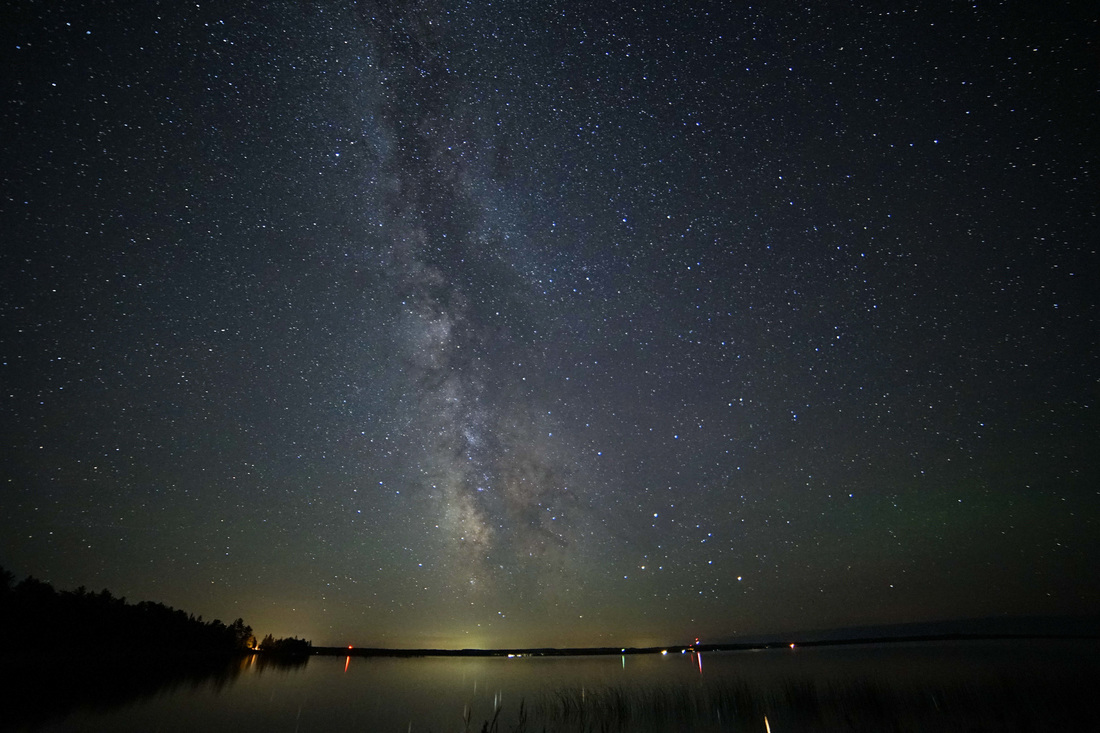|
TODAY WE TAKE A BREAK FROM BUSINESS to answer some questions posed by readers about an earlier post. Specifically, questions about my experiences with night photography from readers of this blog. Thanks for your interest in the topic.
Those who know say it takes between 30 and 45 minutes until your eyes fully adjust to the night so that you can see well under a star filled sky. You learn these kinds of things when you take up night photography and have to manipulate the controls of a full frame camera in the dark. Shine a regular flashlight at the camera and your adjustment time begins anew but use a red light and you be able to see without resetting your eyes to daylight mode. This is another thing you learn and the reason why you see small red lights shining here and there when you photograph the Milky Way from a dark site with other photographers. The first time I ventured out into the middle of the night to try and photograph the night sky was a few years ago while we were visiting Arches National Park in Utah. It felt a bit weird heading out into the dark alone. Much of our obsession with lighting our cities and homes, I think, reflects a longstanding fear we have of the dark. It can be unsettling being in the dark when you can hear but cannot see what is going on around you. Trying something new and unfamiliar was part of what motivated me to night photography in the first place. You could see the Milky Way in the night sky from my suburban neighborhood when I was a kid long ago. I remember the awe we all felt on a clear moonless night when the Milky Way showed best. In most cities now, that’s not a realistic option because of how much more light we flood our skies with. So my other motivation was to visit a sky again that I already knew but had, like most of us, lost. On my first night in Arches a few years back I had the skies mostly to myself. My only company was a pack rat who kept running in and out of the beam of my flashlight and, after an hour or two, a male voice from the parking area nearby wanting to know what I was doing. Eventually, the voice turned into a man named Art who had read about night photography and walked over to watch the process. Otherwise, it was just me, the sky and an occasional car driving by on the park road. In the few years that passed between that outing and my trip to Utah this Spring, cameras have improved and much has been written about photographing the night sky. So, I was not sure what to expect this time. Would there be more people out taking photographs? Would I get better pictures? The first clear night skies we had was at Capitol Reef National Park in late April. Heading out at 2:00 a.m. to catch the Milky Way without the moon, I drove 15 minutes into the Park, set up and shot for a few hours before returning to the motel. I did not see a single person or car. The cold, the quiet, the spectacularly lit sky and the isolation were invigorating. A few days later, also late into the night but this time at Arches National Park, I found myself in the company of others. In fact, the place was alive with photographers of different skill levels speaking multiple languages. It was the new moon which is ideal for shooting the Milky Way but the bigger difference had to be the existence of camping grounds within the park. The extra photographers made the process more challenging as people would flood an area with headlights or flashlights messing up your vision and your shots. But it also had the feeling of an event, with folks sharing an interest and working together to get shots. And, some of the shots were beautiful. My latest trip was to a park designated a Dark Sky Site by the International Dark Sky Foundation. The site consisted of a long shoreline overlooking lake Michigan that you accessed by walking through the woods on an unlit path for a little over a mile. While walking down the path my eyes adjusted to the dark and I could get glimpses of the sky through the trees. When I arrived at the shoreline the sky was filled with the light from the Milky Way and there were dozens of people on the beach enjoying the star filled sky. A few had cameras but most were spread out on blankets enjoying the dark and the night sky. If you have an interest in getting out yourself, let me know. This posting is in response to questions asked since my first posting about the night skies. The photograph above is copyright Clinton Richardson 2016. It was taken along the shore of Lake Michigan at Headlands State Park in Northern Michigan. The venture moola blog comes to you from Atlanta, Georgia. Find it at readjanus.com. Copyright Clinton Richardson.
Comments are closed.
|
the blog
Travel, history, and business with original photos.
your hostClinton Richardson - author, photographer, business advisor, traveler. Categories
All
Archives
July 2023
Follow us on Facebook
|
Check out Ancient Selfies a 2017 International Book Awards Finalist in History and 2018 eLit Awards Gold Medal Winner and
Passports in his Underpants - A Planet Friendly Photo Safari a 2020 Readers' Favorite Winner in Nonfiction
Site Copyright 2024 by Clinton Richardson

 RSS Feed
RSS Feed